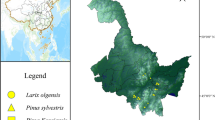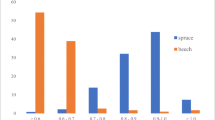Abstract
Diameter distributions of juvenile loblolly pine (Pinus taeda L.) were characterized utilizing a two-parameter Weibull distribution to aid in forecasting and simulation of young stands. Juvenile diameter distributions were studied to gain insight into the effects of various stand-level factors. Results show that diameter distributions in juvenile loblolly pine stands can be successfully characterized with the two-parameter Weibull function. Repeated measures analysis detected significant planting density, age, and age by planting density interaction effects for the scale and shape parameter estimates from the two-parameter Weibull distribution. Using parameter recovery techniques, estimated diameter distributions were derived from easily attainable stand-level characteristics (i.e. basal area per hectare, planting density, age, and quadratic mean diameter). A thorough understanding of juvenile diameter distributions should prove especially useful for operational planning of stands on short rotations that require estimates of productivity at early ages.
Similar content being viewed by others
References
Amateis R.L., Burkhart H.E. and Zedaker S.M. 1988. Experimental design and early analyses for a set of loblolly pine spacing trials. USDA Forest Service General Technical Report NC-120 North Central Forest Experimental. Station, pp. 1058–1065.
R.L. Bailey T.R. Dell (1973) ArticleTitleQuantifying diameter distributions with the Weibull function For. Sci. 19 97–104
R.L. Bailey T.M. Burgan E.J. Jokela (1989) ArticleTitleFertilized midrotation-aged slash pine plantations – stand structure and yield prediction models South. J. Appl. For. 13 76–80
Baldwin V.C. and Feduccia D.P. 1987. Loblolly pine growth and yield prediction for managed West Gulf plantations. USDA Forest Service Research Paper SO-236 South. Southern Forest Experimental Station, 27 p.
J.R. Brooks B.E. Borders R.L. Bailey (1992) ArticleTitlePredicting diameter distributions for site-prepared loblolly and slash pine plantations South. J. Appl. For. 16 130–133
T.E. Burk J.D. Newberry (1984) ArticleTitleA simple algorithm for moment-based recovery of Weibull distribution parameters For. Sci. 30 329–332
Burkhart H.E., Farrar K.D., Amateis R.L. and Daniels R.F. 1987. Simulation of individual tree growth and stand development in loblolly pine plantations on cutover, site-prepared areas. School of Forestry and Wildlife Resources, Virginia Polytechnic Institute and State University, Publication FWS-3-72, 47 p.
Q.V. Cao H.E. Burkhart (1984) ArticleTitleA segmented distribution approach for modeling diameter frequency data For. Sci. 30 129–137
R.B. D’Agostino M.A. Stephens (Eds) (1986) Goodness-of-Fit Techniques Marcel Dekker New York, NY
W.L. Hafley H.T. Schreuder (1977) ArticleTitleStatistical distributions for fitting diameter and height data in even-aged stands Can. J. For. Res. 7 481–487
D.M. Hyink J.W. Moser (1983) ArticleTitleA generalized framework for projecting forest yield and stand structure using diameter distributions For. Sci. 29 85–95
J.D. Lenhart (1988) ArticleTitleDiameter-distribution yield-prediction system for unthinned loblolly and slash pine plantations on non-old-fields in East Texas South. J. Appl. For. 12 239–242
C. Lin P.M. Morse (1975) ArticleTitleA compact design for spacing experiments Biometrics 31 661–671
C.G. Lorimer A.G. Krug (1983) ArticleTitleDiameter distributions in even-aged stands of shade-tolerant and midtolerant tree species Am. Midland Naturalist 109 331–345
J.P. McTague R.L. Bailey (1987) ArticleTitleCompatible basal area and diameter distribution models for thinned loblolly pine plantations in Santa CatarinaBrazil For. Sci. 33 43–51
D.N.P. Murthy M. Xie R. Jiang (2004) Weibull Models John Wiley & Sons Hoboken, NJ
P.J. Radtke H.E. Burkhart (1999) ArticleTitleBasal area growth and crown closure in a loblolly pine spacing trial For. Sci. 45 35–44
K. Rennolls D.N. Geary T.J.D. Rollinson (1985) ArticleTitleCharacterizing diameter distributions by the use of the Weibull distribution Forestry 58 57–66
O. Schabenberger F.J. Pierce (2002) Contemporary Statistical Models for the Plant and Soil Sciences CRC Press Boca Raton, FL
M. Sharma H.E. Burkhart R.L. Amateis (2002) ArticleTitleModeling the effect of density on the growth of loblolly pine trees South. J. Appl. For. 26 124–133
A. Zellner (1962) ArticleTitleAn efficient method of estimating seemingly unrelated regressions and tests for aggregation bias J. Am. Stat. Assoc. 57 348–368
Author information
Authors and Affiliations
Corresponding author
Rights and permissions
About this article
Cite this article
Bullock, B.P., Burkhart, H.E. Juvenile diameter distributions of loblolly pine characterized by the two-parameter Weibull function. New Forest 29, 233–244 (2005). https://doi.org/10.1007/s11056-005-5651-5
Received:
Accepted:
Issue Date:
DOI: https://doi.org/10.1007/s11056-005-5651-5




